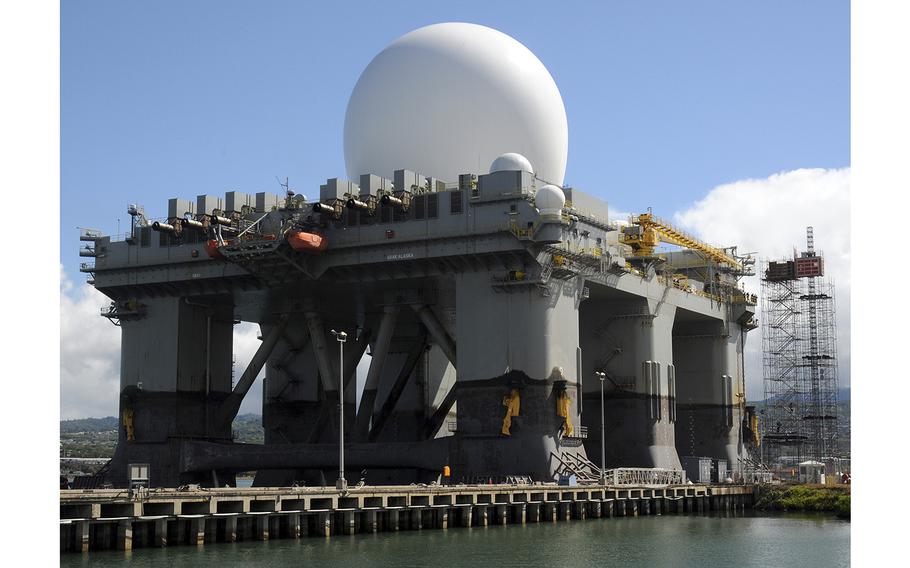
The Sea-Based X-band Radar arrives in Pearl Harbor on July 14, 2010. (Robert Stirrup/U.S. Navy)
(Tribune News Service) — The Missile Defense Agency’s massive Sea Based X-Band Radar, or SBX-1, is in Pearl Harbor for repairs and upgrades after a long voyage.
Known to many Hawaii residents as “the golf ball “ for its large white dome, the 280-foot-tall radar has been in Hawaii since October after 662 days out at sea—the longest it has ever deployed.
The impact of operating in the Pacific Ocean, usually near Alaska, is evident.
Rough seas and stormy weather have rusted its exterior, and workers with Pacific Shipyards International are laboring to make it as good as new. “All of the upgrades that we’re doing on board totals about $68 million, “ said SBX-1 Product Manager Bob Dees, a former Navy sailor who now works for the MDA overseeing the radar.
The 2, 400-ton radar operates on top of a converted oil rig, allowing it to move around the Pacific monitoring missile threats. It’s operated by a 72-strong crew of personnel that rotate on and off every nine weeks—transferring and getting resupplied at sea. The crew is made up mostly of contractors, including personnel from defense giants Raytheon and Northrop Grumman.
The SBX-1 is part of a larger missile defense system that includes satellites and radars in Japan, Alaska and California that work together to track missiles in the Pacific. Most radars of its kind are stationary, but the unique platform of the SBX allows it to operate from anywhere in the ocean, using its own propulsion system to move.
Dees said that gives it an advantage in being able to track missiles and adjust to the earth’s curvature, explaining, “We have to see it in real time so that they can figure out that they want to shoot it, initialize the interceptor and get it launched so they can intercept before it gets to where it does some damage.”
The Pentagon has shown growing concerned about the increasingly sophisticated missile arsenals of China, Russia and North Korea. In particular, analysts are alarmed by the proliferation of new hypersonic missiles that are designed to bypass radars.
“They’re adding decoys and jammers ; they’re adding things that make it harder. A depressed trajectory means you’ve got less time to watch and engage the target, “ Dees said, noting that a major concern is “long-range hypersonic cruise missiles that fly lower, and you can’t see them as far over the curve of the earth.”
The SBX-1 has at time been a controversial program.
A 2015 investigation into America’s missile defense systems by the L.A. Times looking at cost overruns, maintenance challenges and technical problems called the SBX “a $2.2-billion flop.” Some analysts at the time argued that while the SBX-1 could get very detailed imagery on distant missiles and other objects, its field of vision was too narrow for a situation with multiple missiles and decoys.
But Dees said the radar has continuously been upgraded with an eye toward supporting present—and future—operations.
“We’re supporting Space Force and Space Command with their request for updates on things that are up in orbit with our very sensitive radar, “ said Dees. “We expect that business is going to continue to grow, and we’re working for additional automation.”
There have occasionally been discussions about building a second SBX to create more mobile missile defense monitoring, but Dees said that such an effort would be costly.
“It’s much more expensive to run a ship than it is a building, “ Dees explained. “When you look at procurement cost, it’s not much different. But the life cycle cost, SBX will last 30 or 40 years, so if we cost double what a building costs, that’s a lot of money over that time.”
Dees said the “operational flexibility “ the SBX-1’s mobile platform provides is “valuable enough that they were OK for the expenditures just for that, “ but that at least for now, discussions of future radars tend to focus on land-based ones.
Developing land-based radars has its own challenges. In 2022, Hawaii’s congressional delegation stopped pushing to fund the Homeland Defense Radar Hawaii, known as the HDR-H, after years of fighting efforts both by the Pentagon and Hawaii residents to defund the program.
In 2018 the MDA awarded Lockheed Martin a contract for $585 million to develop, build and deliver the radar with work being done in New Jersey and Hawaii. By 2019 the estimated cost for the complete facility was $1 billion, but cost estimates ballooned to $1.9 billion just a year later as the military scouted sites and accounted for logistical challenges of building it in the islands.
Many local residents pushed back on the project, arguing that building it would destroy habitats for endangered species and threaten Native Hawaiian cultural sites.
The Pentagon tried to suspend funding and look at alternatives, but the Hawaii delegation convinced fellow lawmakers to put money back into the project. In a tense exchange during a Senate Armed Services Committee hearing in March 2020, then-Defense Secretary Mark Esper told Hawaii’s Sen. Mazie Hirono that “if I develop a system and can’t put it somewhere, it has no effect. It’s wasted money.”
The Pentagon is conducting a review of Pacific missile defense and sensing capabilities—including the possibility of in-development space-based systems that could be available in the near future. Dees said that “very high levels of government are talking about what’s the right architecture mix between overhead sensors, ground-based radars on land and surface radars on ships.”
(c)2023 The Honolulu Star-Advertiser
Visit The Honolulu Star-Advertiser at www.staradvertiser.com
Distributed by Tribune Content Agency, LLC.